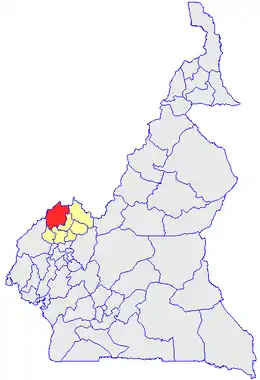Menchum | |
|---|---|
 Department location in Cameroon | |
| Coordinates: 6°38′36″N 10°08′23″E / 6.6433°N 10.1397°E | |
| Country | |
| Province | Northwest Province |
| Capital | Wum |
| Area | |
| • Total | 1,725 sq mi (4,469 km2) |
| Population (2005) | |
| • Total | 161,998 |
| Time zone | UTC+1 (WAT) |
Menchum is a department of Northwest Province in Cameroon. The department covers an area of 4469 km2 and as of 2005 had a total population of 161,998.[1] The capital of the department lies at Wum. The Menchum River drains this area, flowing westward into Nigeria to join the Benue River.
History
Menchum Division got its names from the Menchum River
Cameroon became a German Protectorate in July 14th 1884. By 1916, Germany was defeated during the First World War by the Allied Forces, and Cameroon was handed over to France and Britain under the League of Nations mandate agreement of 1922. Britain and France were mandated by the League of Nations to administer and prepare Cameroon for self-government at a later date. The Mandate Agreement resulted in the partition of Cameroon between the French and the British who had to enact policies that would ensure efficiency in the administration of their respective portions of the Mandate Territory of Cameroon. From 1916 to 1922, Britain had no formal administrative policy for the Cameroon and Nigeria. It was only in 1923 that the British Orders-in-Council created the then administrative Units known as Native Authorities (NA) headed by Traditional Rulers. The 1923 Orders-in-Council established British colonial Policy for the Cameroons and Nigeria. The Orders-in-Council equally enacted that British Laws which were already applicable in Nigeria be extended to both Northern and Southern Cameroons. By this policy, each village or Chieftaincy or Fondom constituted a Native Authority. The 1923 Orders-in-Council introduced a native administrative system known as Indirect Rule, through which Britain administered it's colonies in Africa through indigenous Chiefs and Traditional Institutions. This administrative system therefore excluded the educated Elites from administration. The administration was mounted by Traditional Rulers who were for the most part not literate or well educated, hence lacked both managerial capabilities and financial resources to carry out socio-economic development. This constituted a major flaw of the Native Authority sytem of administration. This flaw neccessitated the Administrative Reforms of 1949 by the British. In 1949, Britain decided to create Local Government Units in the Cameroons and Nigeria. Different Chiefdoms or Fondoms were merged together to constitute Divisional Local Governement Units. Thus, the today North West Region was transfromed into a province known as the Bamenda Province with three Divisions, namely; Bamenda Division, Wum Division and Nkambe Division. South West Region was equally divided into three Divisions, namely; Mamfe Division, Kumba Division and Victoria Division. These Divisions had deliberative and Legislative Powers and their representatives were elected through universal suffrage. They were empowered to ensure development in all its facets.[2]
Subdivisions
The department is divided administratively into 5 communes and in turn into villages.
From 1992 to 1996, Menchum witnessed yet another evolution. The Constitutional Reforms of 1996 in Cameroon transformed Provinces into Regions and did away with the previous administrative units called Districts, and replaced them with Subdivisions. Thus, from 1996, Districts ceased to exist as administrative units in Cameroon. The Subdivisions were each accompanied by Municipal Councils headed by Mayors elected via universal suffrage. The four subdivisions that make up Menchum today are;
References
- ↑ "Population and Housing Census - Cameroon Data Portal".
- ↑ Archived October 1, 2007, at the Wayback Machine
